After almost 30 years, Amazon’s original book business is booming, leaked document shows
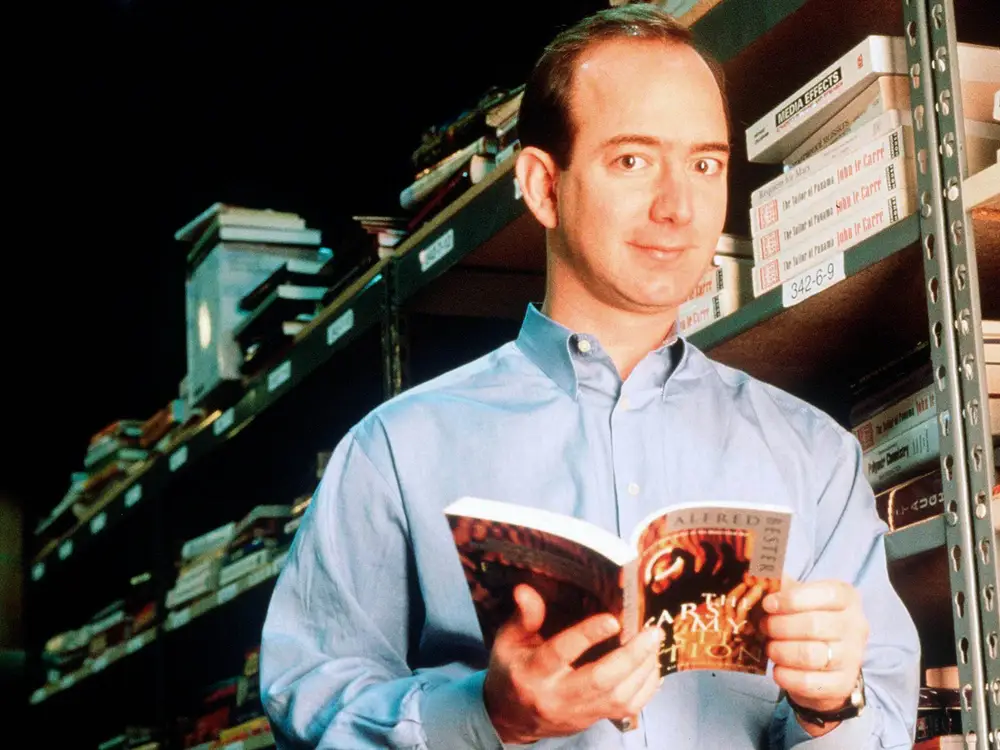
Jeff Bezos, founder of Amazon.com, poses with a book in an Amazon warehouse, Seattle, Washington.
Amazon got its start in 1994 by selling books. Decades later, this original business is thriving and massively outperforming its digital cousin, e-books.
This is according to a detailed internal document obtained by B-17 that reveals a host of new information and insights about Amazon’s book business and the broader publishing landscape.
Reliable data on this industry is limited or tightly controlled, so it’s sometimes difficult to get handle on the scope of the book business. This makes the new Amazon data particularly notable, especially as antitrust questions still linger about the company’s dominance of the sector.
In the first 10 months of 2022, Amazon had $16.9 billion in gross merchandise sales from its books category, the document shows. GMS measures the total sales volume of print and digital books, including e-books and audiobooks.
That translates to nearly $1.7 billion in average monthly book sales volume, or roughly $400 million per week. In the US alone, Amazon recorded about $9.5 billion in total book sales volume in those 10 months.
This shows how well Amazon has done in keeping its original business thriving over almost three decades. It also reveals how physical books have endured as a reading format, while ebooks have not lived up to their early promise when Amazon launched the Kindle e-reader back in 2007.
“There is nothing broken about books in print format. Many people, myself included, tend to prefer holding a book in our hands and reading a printed book,” said John Warren, a director and associate professor of George Washington University’s publishing program.
“Monopoly power”
Amazon’s book business has drawn antitrust scrutiny over the years. The Federal Trade Commission’s case against Amazon last year mentioned Amazon’s book segment, while the American Booksellers Association urged the FTC and the Justice Department to focus on the company’s “monopoly power” over the market.
The document obtained by B-17 is 25 pages long and is marked confidential. It was used for a weekly business review at Amazon. The company doesn’t publicly disclose book sales, nor does it give a revenue breakdown of each retail category.
In an email, Amazon spokesperson Lindsay Hamilton said the company “continues to operate in a competitive bookselling environment,” where online retailers, national chains, and independent booksellers have “grown significantly” in recent years.
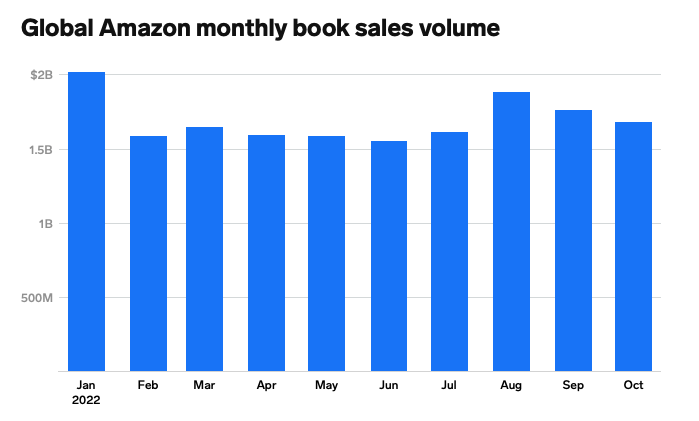
The US accounts for over half of the sales
The document reveals a few staggering numbers that show how big Amazon’s book business is.
Here are a few standout sales figures:
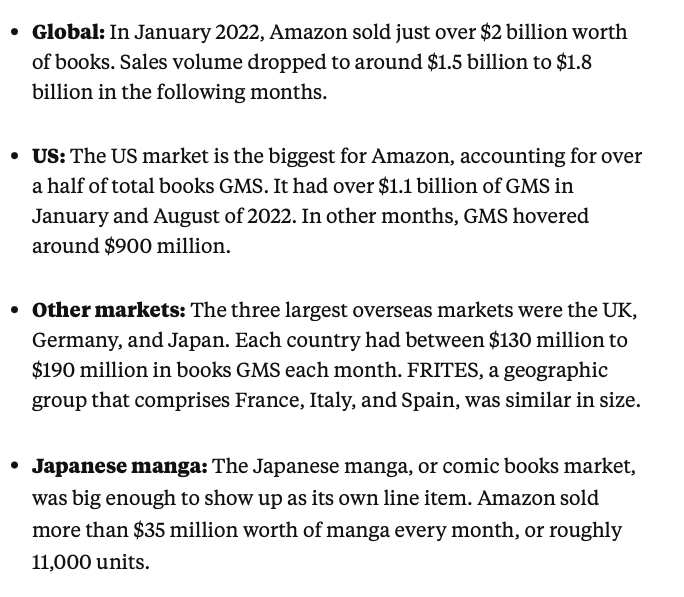
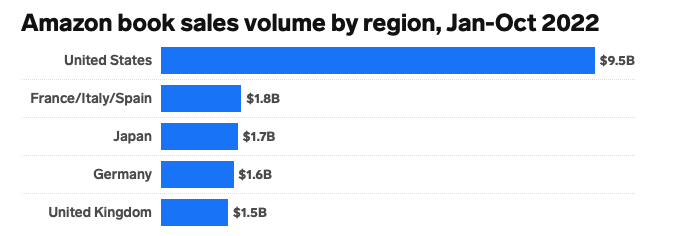
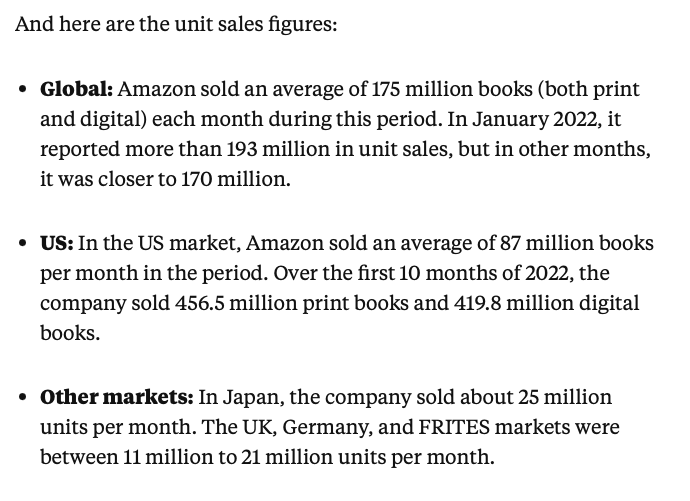
Mixed signals
Given Amazon’s GMS for books in the first 10 months of 2022 was close to $17 billion, it’s likely the company sold more than $20 billion worth of books for the full year.
While Amazon is a powerful player in the books business, it’s hard to tell whether the company is having an adverse impact on the market. Global book sales grew 8.8% in 2023 from 2019, according to industry data provider Circana. And the American Booksellers Association reported an 11% increase in memberships and 200 new independent bookstore openings in 2023.
Retailers are showing mixed signals. Barnes & Noble is on pace to open 50 new stores in 2024, the highest number of store openings in 15 years. But Costco recently decided to stop selling books, unless it’s the holidays or other special occasions. Booktopia, an online bookseller in Australia, is struggling to survive.
E-books versus print
One notable datapoint in the Amazon document is the difference between Amazon’s print and e-book revenue.
In the first 10 months of 2022, Amazon sold more than $7.4 billion worth of print books in the US, while e-books GMS were around $2 billion.
The gap in the average sales price for the two book formats was also notable. Print books had an average sales price of around $15 versus roughly $4.50 for e-books, according to the document.
While Amazon was a pioneer in e-books, this data indicates that digital book formats may not have grown as fast as many industry experts once predicted.
A 2022 survey from the Pew Research Center showed that print book readers in the US still far outpaced the number of e-book readers, with 65% of adults saying they had read a print book in the past 12 months compared to 30% who picked up an e-book.
Warren, the associate professor from George Washington University, told us that e-books were once anticipated to take nearly 80% of the market. But those projections have largely failed to live up to expectations, as print books are still the preferred mode of reading for many people. Still, he said, digital formats represent an “increasingly important part” of most publishers’ revenue.
Amazon’s statement
Hamilton, the Amazon spokesperson, shared some other thoughts, touching on the internal document and the company’s book business in an emailed statement:
“Amazon has a written narrative culture, which means at any given time there are thousands of documents moving around the company, providing information at a point in time and with varying levels of review and accuracy,” Hamilton wrote. “We’re on a mission to inspire customers to read more and get the most out of reading. We offer innovative, unparalleled reading experiences; the widest possible selection; options for our customers to read how they want, when they want; and a variety of affordable ways to read.”






